Postgraduate Diplomas in Reconstructive Microsurgery in short
As the faculty and staff work with you to achieve your professional goals, you will experience the highly personal nature of an Diploma program like no other.
One year educational program in search of excellence in reconstructive microsurgery.
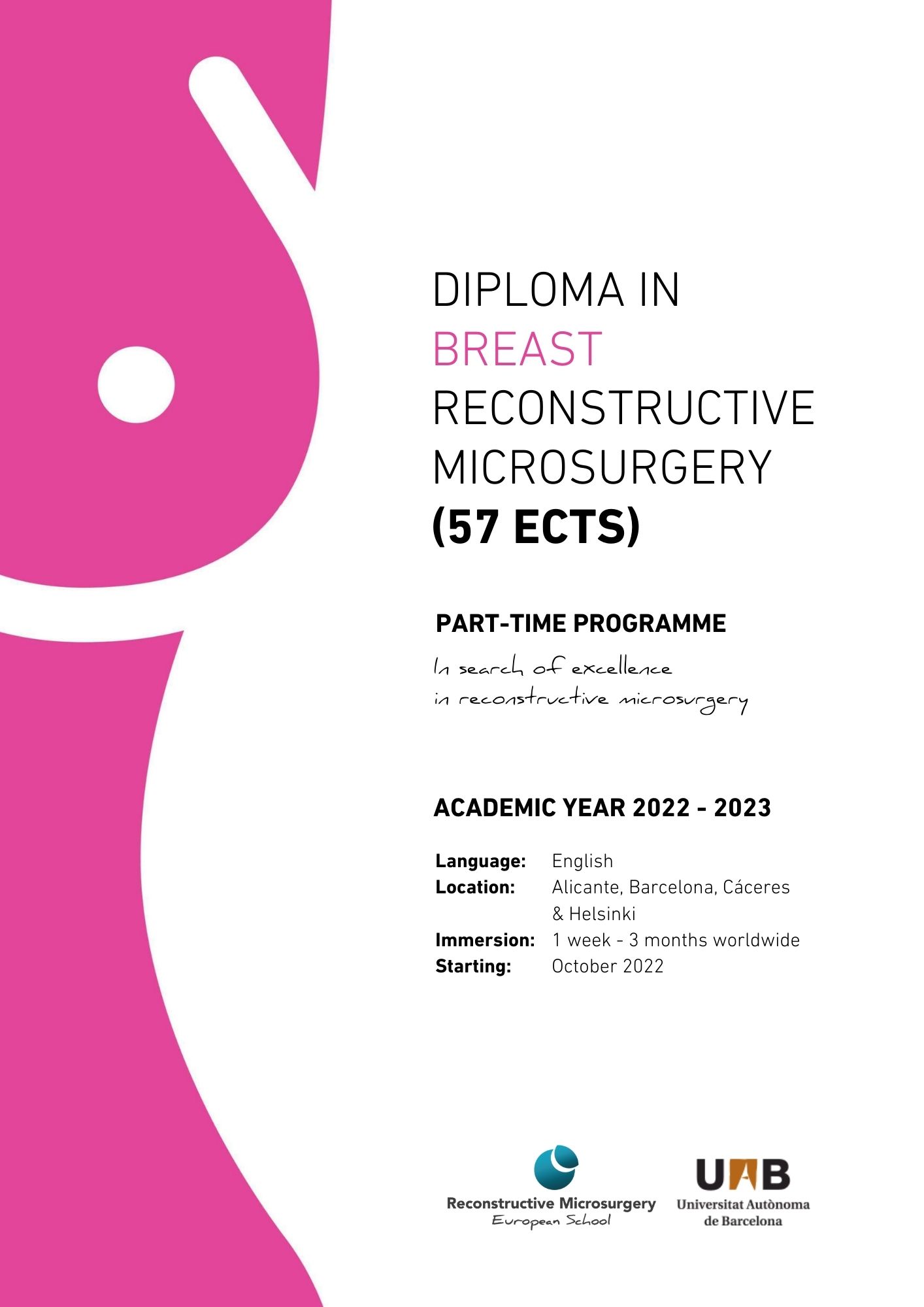
Breast Diploma educational programme (57 ECTS) consists in:
- 3 face-to face sessions held in 2 cities, 3 sessions on-line
- A period of clinical immersion training in out-standing hospitals around the world
- An online course to develop the methodological aspects of clinical research and a Final work.
If you are unable to travel, you have the possibility to take the clinical training modules on-line.
MASTERCLASS: ESSENTIAL CONCEPTS IN MICROSURGERY
Theoretical introduction to the basic concepts of microsurgery.
- Sentinel node biopsy approach in internal mammary chain
- Skin sparing mastectomy axillary lymphnode clearence Implant reconstruction with ADM
- Flap dissections: Latissimus dorsi, DIEP, SGAP, TUG, PAP
- Lower limb and pelvis
- PAP
- Lumbar perforator flap (LPF)
- Inferior gluteal artery perforator flap (IGAP)
- Superior gluteal artery perforator flap (SGAP)
- Gracilis (ATMG)
WORKSHOP: FLAP DISSECTION IN FRESH CADAVER
Trunk
- Internal mammary fascio-cutaneous flaps
- Intercostal flaps
- Scapulo-dorsal flaps: latissimus dorsi, thoracodorsal artery perforator flap (TDAP), scapular flap, parascapular flap and chimeric flaps
- Abdominal wall flaps: musculo-cutaneous rectus abdominis flap (TRAM), deep inferior epigastric perforator flap (DIEP) and Taylor, superficial inferior epigastric artery flap (SIEA)
- Free lymph node transfer
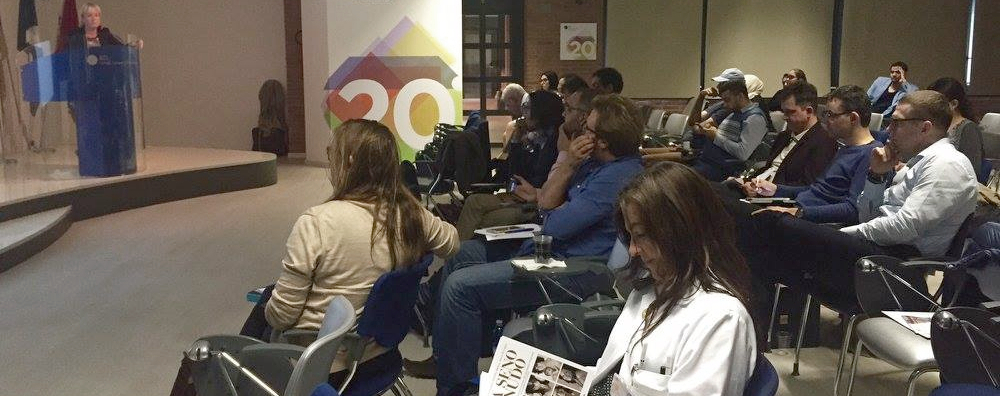
Intensive training course on basic microsurgical skills using a small animal model (rat).
- Basic management of experimental animal, microscope and instrumentation
- Microsurgical suture practice on surgical gloves
- Epineural and perineural suture of the sciatic nerve
- End-to-end suture of the carotid artery and femoral artery
- End-to-end suture of the jugular vein and femoral vein
- Aorto-iliac end-to-end suture
- End-to-side suture between femoral artery and vein
- Jugular vein graft to carotid artery
- “In situ” groin flap
- Distant groin flap to the neck
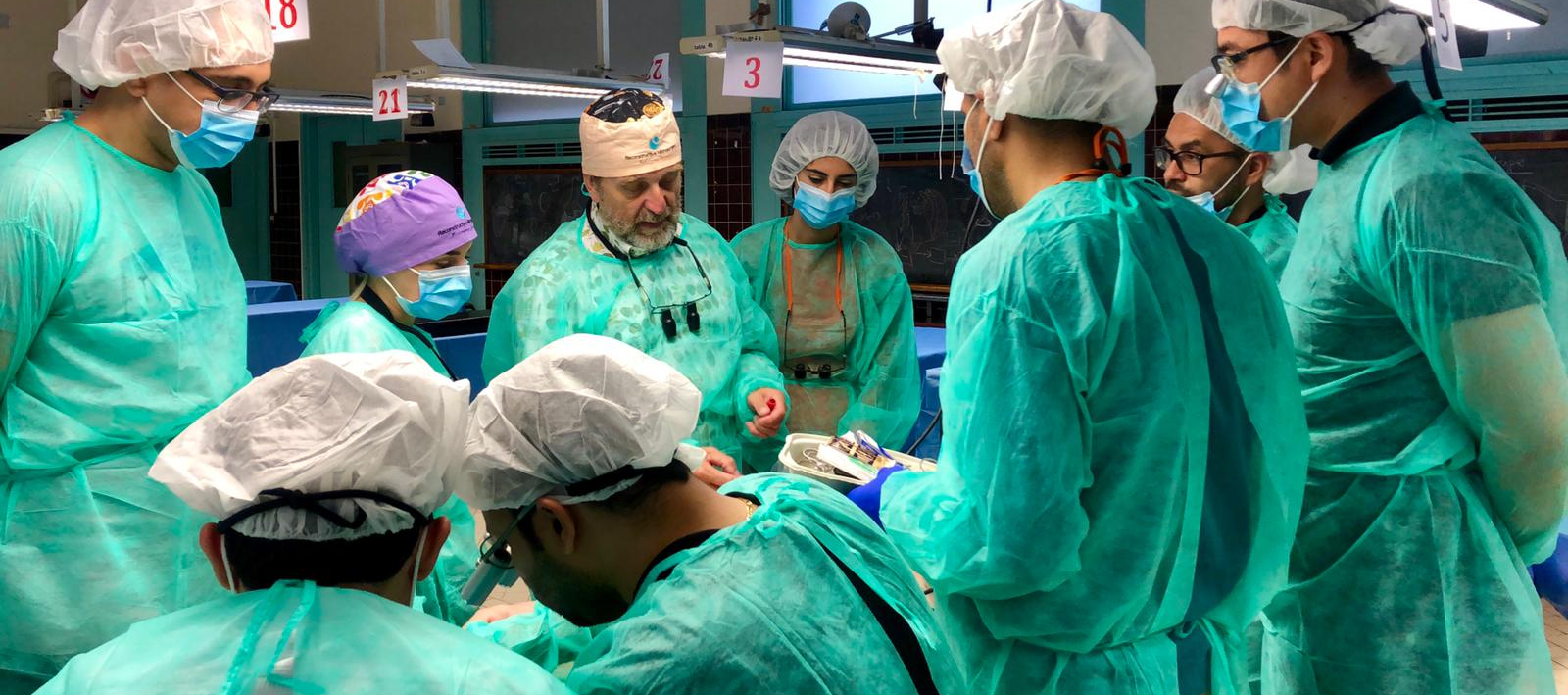
Intensive course on dissection of perforator flaps in live animals (pig) and basic supermicrosurgical skills training.
- Perforator flap anatomy
- Preoperative planning of perforator flaps
- Dissection technique of perforator flaps
- Fundamentals of microsurgical techniques
- Head and Neck Reconstruction with Microsurgical Flaps
- “Hands on” Dissection Session:
Gluteal and dorsal perforator flaps / Free style perforator flaps / Transferring the flaps to the recipient vessels / Super microsurgical flaps / Lymphatic channel dissection / Lymph node transfer
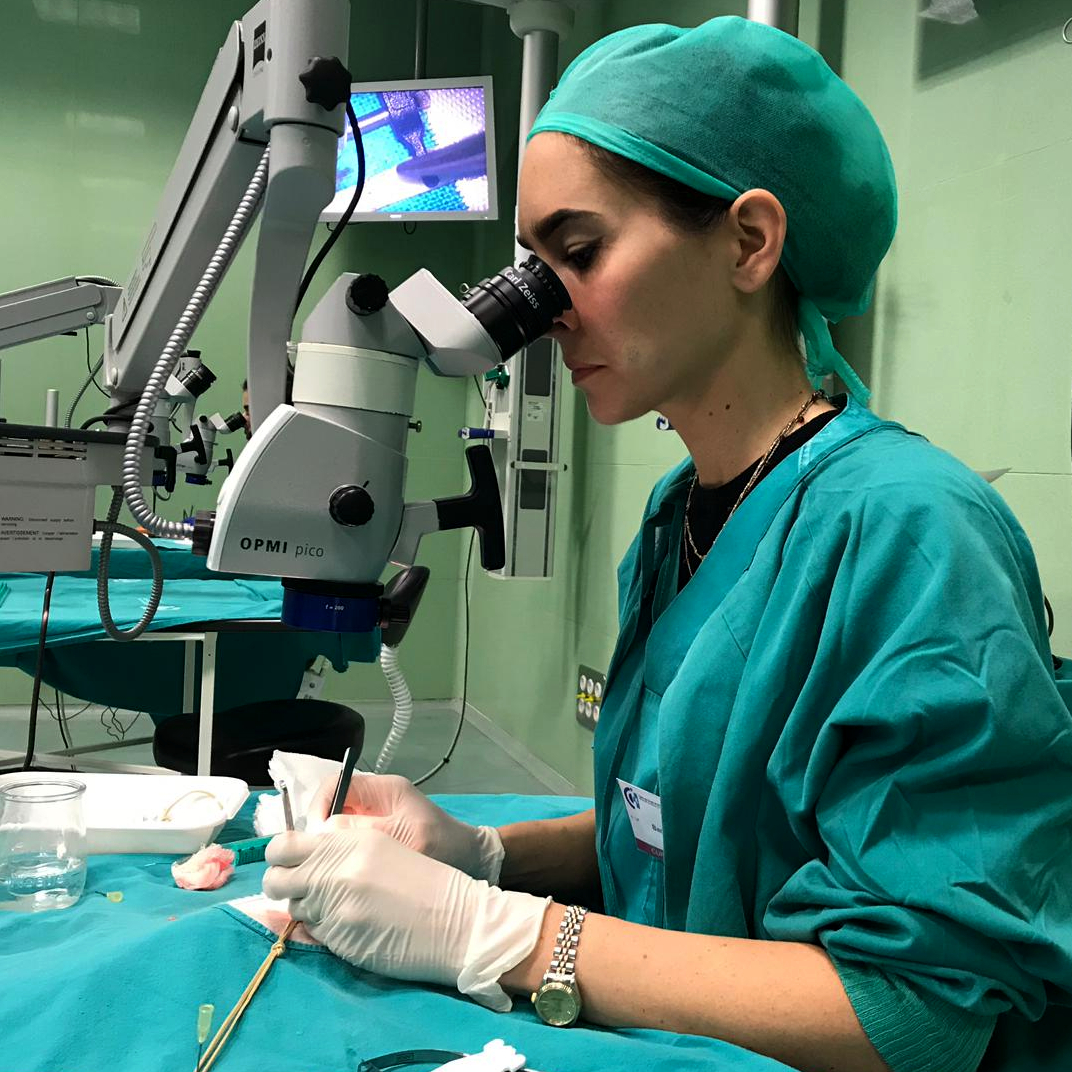
Live webcast surgery will also be shown and students’ interactive participation will be encouraged.
- Oncological management in breast tumors
- Reconstructive planning in breast tumors
- Breast reconstruction with implant vs autologous tissue reconstruction
- Immediate and delayed reconstruction
- Oncoplastic breast surgery: glandular and perforator flap techniques
- Breast reconstruction:
DIEP flap / SIEA flap / TAP flap / SGAP flap / IGAP flap / Fat grafting / Transverse myocutaneous gracilis flap (TMG) / Extended TAP / PAP / Lumbar perforator flap / Latissimus Dorsi - Partial breast reconstruction: oncoplastic and perforator flap techniques
- Autologus flap reconstruction with fat grafting
- Thoracic wall reconstruction
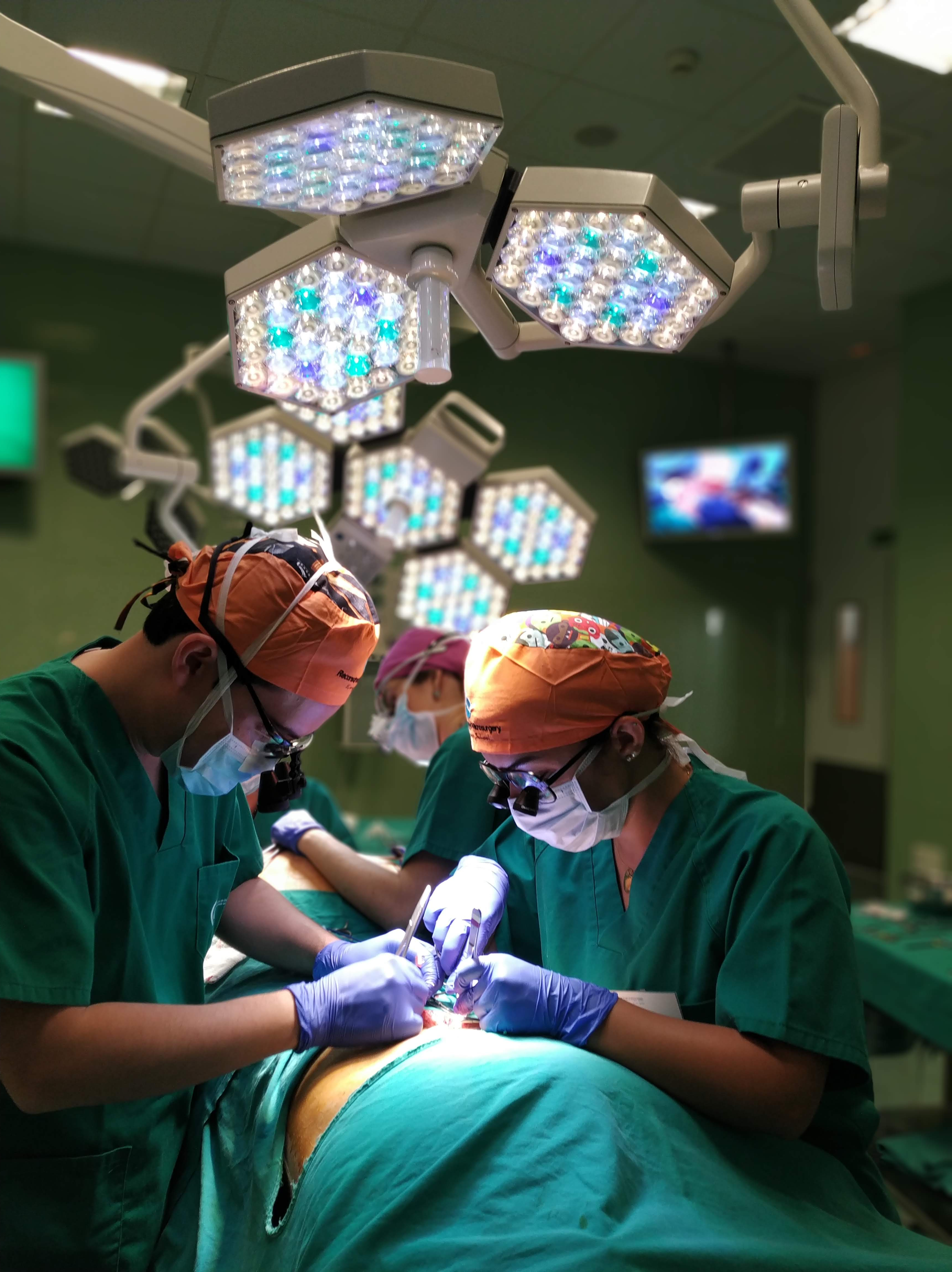
Basic Sciences on breast disease
How to build a breast unit
Imaging Techniques for breast:
- Ultrasound
- Mammogram
- MR imaging
- Breast PET Scan for diagnosis and follow-up
- Interventional radiology: stereotactic breast biopsy, imaging-guided needle breast biopsy, ultrasound guided breast biopsy
Benign breast disease:
- Nipple discharge and the role of ductoscopy
- Inflammatory and related lesions: mastitis, foreign body reactions, recurrent subareolar abscess, mammary duct ectasia, fat necrosis
- Fibrocystic changes: cysts, adenosis, metaplasia, epithelial hyperplasia, ductal lesions, lobular lesions, columnar cell lesions, radial scar and complex sclerosing lesion, intraductal papilloma and papillomatosis
- Benign tumours: fibroadenoma, lipoma, adenoma, hamartoma, granular cell tumour
Management of malignant breast disease:
- Diagnosis of breast cancer:
Clinical examination / Laboratory investigations / Pathological diagnosis / Clinical staging and risk assessment / Prognostic factors
- Treatment:
Adjuvant systemic therapy / Primary chemotherapy (neoadjuvant chemotherapy) in locally advanced breast cancer / Follow-up - Management of metastatic disease:
Staging of metastatic or recurrent breast cancer / Local recurrence / Systemic dissemination / Chemotherapy regimens for recurrent or metastatic breast cancer - Pathological handling of breast cancer excision specimens: fine needle aspiration biopsy and core needle biopsy, mastectomy specimen, mammographically-directed excisions, frozen section diagnosis, surgical pathology report of breast cancer specimens
- Radiotherapy guidelines for breast cancer:
Radiotherapy for ductal carcinoma in situ / Criteria for breast conserving therapy / Post-mastectomy radiotherapy / Radiotherapy after pre-operative - Management of special situations in breast cancer:
Breast cancer in elderly women / Breast cancer in very young women / Breast cancer in male - Breast cancer reserach: How, who and when

Small groups of students will have the opportunity to observe live microsurgical techniques in lymphedema treatment.
Live webcast surgery will be shown and interactive participation will be facilitated
- Acritical evaluation of results conservative treatment of Lymphedema
- Anatomy and physiology of the lymphatic system
- Assessment and surgical treatment of lymphedema
- Vascularised lymphatic node transfer
- Lympho-venous anastomosis
- Combined surgical treatment for lymhedema
- Lymphangiogenesis and the role of growth factors in lymphedema
- Free vascularised nerve flaps
- Microsurgical nanoflaps
- Patient selection to different methods
- Perforator to perforator flap surgery

The programme includes a practical training module with feedback from facilitators. During this period, maximum 4 weeks, students will be involved in clinical cases involving head and neck reconstructive microsurgery. They will present cases to the other students and faculty to clarify doubts and evaluate the surgery.
- Joint review of the microsurgical technique
- Presentation and discussion of complex clinical cases
- Resolution of immediate and delayed post-surgical complications involving the flaps
- Optimization of technique tailored to each student
On-line
We need to investigate to produce knowledge that allows us to reduce the impact of health problems, which involves diagnosing and treating diseases
better. The clinical research is this inescapable filter where the hypotheses that come from basic research, technological innovation or clinical practices must be tested. But for this applied research activity to be sufficiently valid and useful, we must adequately master the essential conceptual and methodological aspects related to the methodology of clinical research. Making it possible is the objective of this module.
At the end of the module, students will be able to:
-
Understand and know how to apply the mostimportant concepts related to clinical research.
-
Know how to ask clinical questions of different types and in a structured way.
-
Promote the design of the most appropriate clinical studies to answer the clinical questions of interest.
-
Conduct searches on scientific publications in a structured, comprehensive and efficient manner.
-
Carry out an adequate critical appraisal to identify the strengths and weaknesses of each study.
-
Understand and apply the most basic statistical concepts to calculate the different measures of association and effect.
.
Final work
Preparation of a comprehensive written research report is an essential part of a valid research experience, and the student should be aware of this requirement at the outset of the project. Interim reports may also be required. Sufficient time should be allowed for satisfactory completion of reports, taking into account that initial drafts should be supervised and corrected by your tutor.

Head and Neck Diploma educational programme (48 ECTS) consists in:
- 3 face-to face sessions held in 2 cities, 2 sessions on-line
- A period of clinical immersion training in out-standing hospitals around the world
- An online course to develop the methodological aspects of clinical research and a Final work
If you are unable to travel, you have the possibility to take the clinical training modules on-line.
Theoretical introduction to the basic concepts of microsurgery:
- History of microsurgery
- Microscope and microsurgical instruments
- Selection of suture material for microsurgical procedures
- Basic & advanced skills in microsurgery
- Preoperative microsurgical planning
- Microsurgical flap monitoring
- Selection of right flap
- Microsurgical flap salvage
- Refinements in microsurgical reconstruction

Flap dissection training using a fresh cadaver model:
- Head and neck:
Submental flap / Temporo-parietal flap / Supraclavicular flap - Upper limb and shoulder:
Lateral arm flap / Radial forearm flap - Lower limb and pelvis:
Inferior gluteal artery perforator flap (IGAP) / Superior gluteal artery perforator flap (SGAP) / Thigh: anterolateral thigh flap (ALTF), medial thigh flap / Gracilis (ATMG) / Osteocutaneous peroneal artery perforator flap / Propeller flaps based on peroneal and tibial perforators / Medial plantar flap - Trunk:
Internal mammary fascio-cutaneous flaps / Intercostal flaps / Scapulo-dorsal flaps: latissimus dorsi, thoracodorsal artery perforator flap (TDAP), scapular flap, parascapular flap and chimeric flaps / Internal Iliac crest: Groin flap, superficial circumflex inguinal perforator flap (SCIP), iliac crest flap / Abdominal wall flaps: musculo-cutaneous rectus abdominis flap (TRAM), deep inferior epigastric perforator flap (DIEP) and Taylor, superficial inferior epigastric artery flap (SIEA) / Free lymphonode transfer
Intensive training course on basic microsurgical skills using a small animal model (rat):
- Basic management of experimental animal, microscope and instrumentation
- Microsurgical suture practice on surgical gloves
- Epineural and perineural suture of the sciatic nerve
- End-to-end suture of the carotid artery and femoral artery
- End-to-end suture of jugular and femoral vein
- Aorto-iliac end-to-end suture
- End-to-side suture of femoral artery and vein
- Jugular vein graft to carotid artery
- “In situ” groin flap
- Distant groin flap to the neck

Intensive course on dissection of perforator flaps in live animals (pig) and basic supermicrosurgical skills training
- Perforator flap anatomy
- Preoperative planning of perforator flaps
- Dissection technique of perforator flaps
- Fundamentals of microsurgical techniques
- Head and Neck Reconstruction with Microsurgical Flaps
“Hands on” dissection section:
- Gluteal and dorsal perforator flaps.
- Free style perforator flaps.
- Transferring the flaps to the recipient vessels.
- Super microsurgical flaps.
- Lymphatic channel dissection.
- Lymph node transfer

Head and neck microsurgical reconstruction procedures will be performed.
The program will include live webcast surgery and students interactive participation will be encouraged.
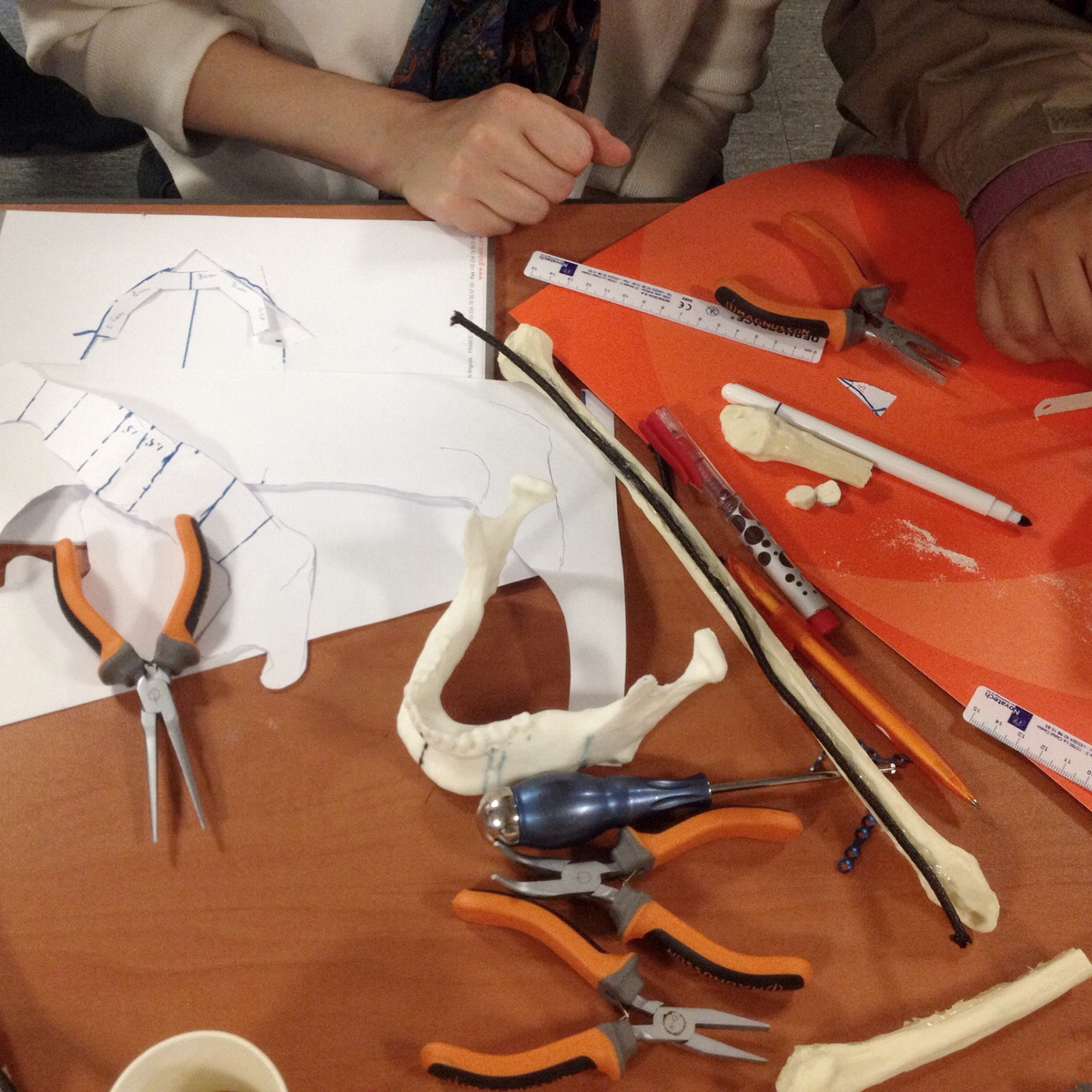
- Oncological criteria in head and neck tumors
- Reconstructive alternatives in head and neck surgery: form, function and aesthetics
- Evaluation and indications for pedicled flap versus free flap
- Selection of the right flap and recipient vessels
- Anterolateral thigh perforator flap (ALTF)
- Thoracodorsal artery perforator flap (TAP)
- Deep inferior epigastric perforator flap (DIEP) with Taylor extension
- Free fibula flap and free osteocutaneous peroneal flap for bone reconstruction
- Deep circumflex iliac artery perforator flap with iliac crest for bone reconstruction
- Radial forearm flap
- Microsurgery in facial palsy
- Facial reanimation
Small groups of students will have the opportunity to observe live microsurgical techniques in lymphedema treatment.
Live webcast surgery will be shown and interactive participation will be facilitated
- Acritical evaluation of results conservative treatment of Lymphedema
- Anatomy and physiology of the lymphatic system
- Assessment and surgical treatment of lymphedema
- Vascularised lymphatic node transfer
- Lympho-venous anastomosis
- Combined surgical treatment for lymhedema
- Lymphangiogenesis and the role of growth factors in lymphedema
- Free vascularised nerve flaps
- Microsurgical nanoflaps
- Patient selection to different methods
- Perforator to perforator flap surgery

CLINICAL IMMERSION
The programme includes a practical training module with feedback from facilitators. During this period, maximum 4 weeks, students will be involved in clinical cases involving head and neck reconstructive microsurgery.
They will present cases to the other students and faculty to clarify doubts and evaluate the surgery.
- Joint review of the microsurgical technique
- Presentation and discussion of complex clinical cases
- Resolution of immediate and delayed post-surgical complications involving the flaps
- Optimization of technique tailored to each student
On-line
We need to investigate to produce knowledge that allows us to reduce the impact of health problems, which involves diagnosing and treating diseases better. The clinical research is this inescapable filter where the hypotheses that come from basic research, technological innovation or clinical practices must be tested. But for this applied research activity to be sufficiently valid and useful, we must adequately master the essential conceptual and methodological aspects related to the methodology of clinical research. Making it possible is the objective of this module.
At the end of the module, students will be able to:
- Understand and know how to apply the most important concepts related to clinical research.
- Know how to ask clinical questions of different types and in a structured way.
- Promote the design of the most appropriate clinical studies to answer the clinical questions of interest.
- Conduct searches on scientific publications in a structured, comprehensive and efficient manner.
- Carry out an adequate critical appraisal to identify the strengths and weaknesses of each study.
- Understand and apply the most basic statistical concepts to calculate the different measures of association and effect.
Final work
Preparation of a comprehensive written research report is an essential part of a valid research experience, and the student should be aware of this requirement at the outset of the project.
Interim reports may also be required. Sufficient time should be allowed for satisfactory completion of reports, taking into account that initial drafts should be supervised and corrected by your tutor.
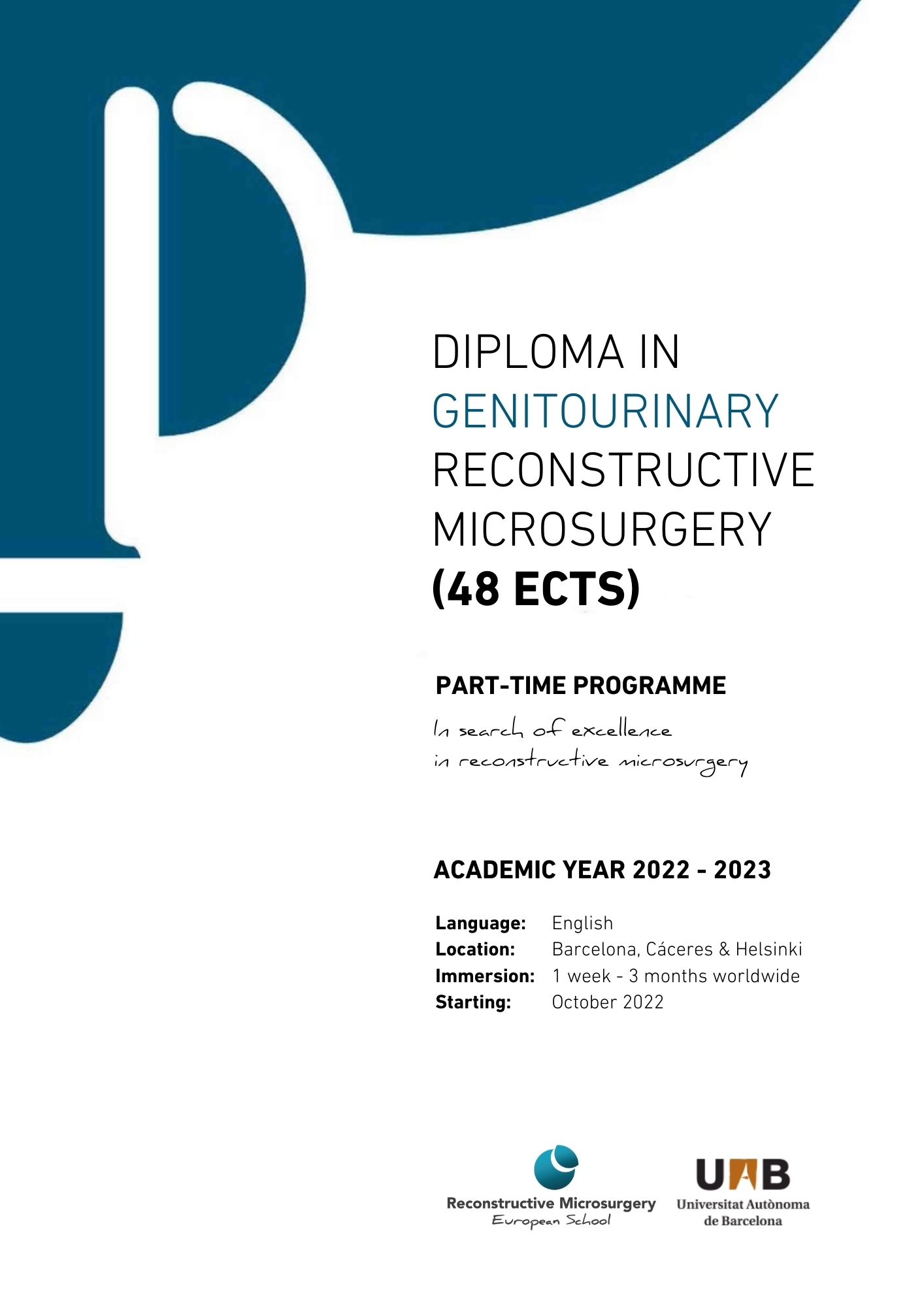
Genitourinary Diploma educational programme (48 ECTS) consists in:
- 3 face-to face sessions held in 2 cities, 2 sessions on-line
- A period of clinical immersion training in out-standing hospitals around the world
- An online course to develop the methodological aspects of clinical research and a Final work
If you are unable to travel, you have the possibility to take the clinical training modules on-line.
Theoretical introduction to the basic concepts of microsurgery.
-
History of microsurgery
-
Microscope and microsurgical instruments
-
Selection of suture material for microsurgical procedures
-
Basic skills in microsurgery
-
Advanced skills in microsurgery
-
Preoperative microsurgical planning
-
Microsurgical flap monitoring
-
Selection of right flap
-
Microsurgical flap salvage
-
Refinements in microsurgical reconstruction

Flap dissection training using a fresh cadaver model:
- Head and neck:
Submental flap / Temporo-parietal flap / Supraclavicular flap - Upper limb and shoulder:
Lateral arm flap / Radial forearm flap - Lower limb and pelvis:
Inferior gluteal artery perforator flap (IGAP) / Superior gluteal artery perforator flap (SGAP) / Thigh: anterolateral thigh flap (ALTF), medial thigh flap / Gracilis (ATMG) / Osteocutaneous peroneal artery perforator flap / Propeller flaps based on peroneal and tibial perforators / Medial plantar flap - Trunk:
Internal mammary fascio-cutaneous flaps / Intercostal flaps / Scapulo-dorsal flaps: latissimus dorsi, thoracodorsal artery perforator flap (TDAP), scapular flap, parascapular flap and chimeric flaps / Internal Iliac crest: Groin flap, superficial circumflex inguinal perforator flap (SCIP), iliac crest flap / Abdominal wall flaps: musculo-cutaneous rectus abdominis flap (TRAM), deep inferior epigastric perforator flap (DIEP) and Taylor, superficial inferior epigastric artery flap (SIEA) / Free lymphonode transfer
Intensive training course on basic microsurgical skills using a small animal model (rat):
- Basic management of experimental animal, microscope and instrumentation
- Microsurgical suture practice on surgical gloves
- Epineural and perineural suture of the sciatic nerve
- End-to-end suture of the carotid artery and femoral artery
- End-to-end suture of jugular and femoral vein
- Aorto-iliac end-to-end suture
- End-to-side suture of femoral artery and vein
- Jugular vein graft to carotid artery
- “In situ” groin flap
- Distant groin flap to the neck

Intensive course on dissection of perforator flaps in live animals (pig) and basic supermicrosurgical skills training
- Perforator flap anatomy
- Preoperative planning of perforator flaps
- Dissection technique of perforator flaps
- Fundamentals of microsurgical techniques
- “Hands on” Dissection Session:
Gluteal and dorsal perforator flaps / Free style perforator flaps / Transferring the flaps to the recipient vessels / Super microsurgical flaps / Lymphatic channel dissection / Lymph node transfer

The students will attend live microsurgical reconstruction of external genitalia and functional bladder reconstruction
- Anatomy and physiology of genitourinary system
- Gender reassignment approach
- Microsurgical techniques in penile reconstruction
- Reconstruction of penile defects:
Radial forearm flap / Groin flap / Sensate osteocutaneous fibula flap / ALT flap / Functional phalloplasty / Combined flaps: phalloplasty - Refinements and resolution of complications after total phallopasty
- Penile prosthesis implantation after total phalloplasty
- Bladder functional reconstruction
- Reconstruction after perineopelvic oncological resections:
Abdominoperineal / Gynecological / Urological recections / Functional pelvic floor reconstruction / Reverse vasectomy (vaso-vasostomosy) anastomosis - Microsurgery of the seminal tract
- Perineum disease repair
- Abdominal wall and gluteal reconstruction
Small groups of students will have the opportunity to observe live microsurgical techniques in lymphedema treatment.
Live webcast surgery will be shown and interactive participation will be facilitated
- Acritical evaluation of results conservative treatment of Lymphedema
- Anatomy and physiology of the lymphatic system
- Assessment and surgical treatment of lymphedema
- Vascularised lymphatic node transfer
- Lympho-venous anastomosis
- Combined surgical treatment for lymhedema
- Lymphangiogenesis and the role of growth factors in lymphedema
- Free vascularised nerve flaps
- Microsurgical nanoflaps
- Patient selection to different methods
- Perforator to perforator flap surgery

The programme includes a practical training module with feedback from facilitators.
During this period, maximum 4 weeks, students will be involved in clinical cases involving breast reconstructive microsurgery. They will present cases to the other students and faculty to clarify doubts and evaluate the surgery.
- Joint review of the microsurgical technique
- Presentation and discussion of complex clinical cases
- Resolution of immediate and delayed post-surgical complications involving the flaps
- Optimization of technique tailored to each student
On-line.
We need to investigate to produce knowledge that allows us to reduce the impact of health problems, which involves diagnosing and treating diseases better. The clinical research is this inescapable filter where the hypotheses that come from basic research, technological innovation or clinical practices must be tested. But for this applied research activity to be sufficiently valid and useful, we must adequately master the essential conceptual and methodological aspects related to the methodology of clinical research. Making it possible is the objective of this module.
At the end of the module, students will be able to:
- Understand and know how to apply the most important concepts related to clinical research.
- Know how to ask clinical questions of different types and in a structured way.
- Promote the design of the most appropriate clinical studies to answer the clinical questions of interest.
- Conduct searches on scientific publications in a structured, comprehensive and efficient manner.
- Carry out an adequate critical appraisal to identify the strengths and weaknesses of each study.
- Understand and apply the most basic statistical concepts to calculate the different measures of association and effect.
.
Final work
Preparation of a comprehensive written research report is an essential part of a valid research experience, and the student should be aware of this requirement at the outset of the project.
Interim reports may also be required. Sufficient time should be allowed for satisfactory completion of reports, taking into account that initial drafts should be supervised and corrected by your tutor.
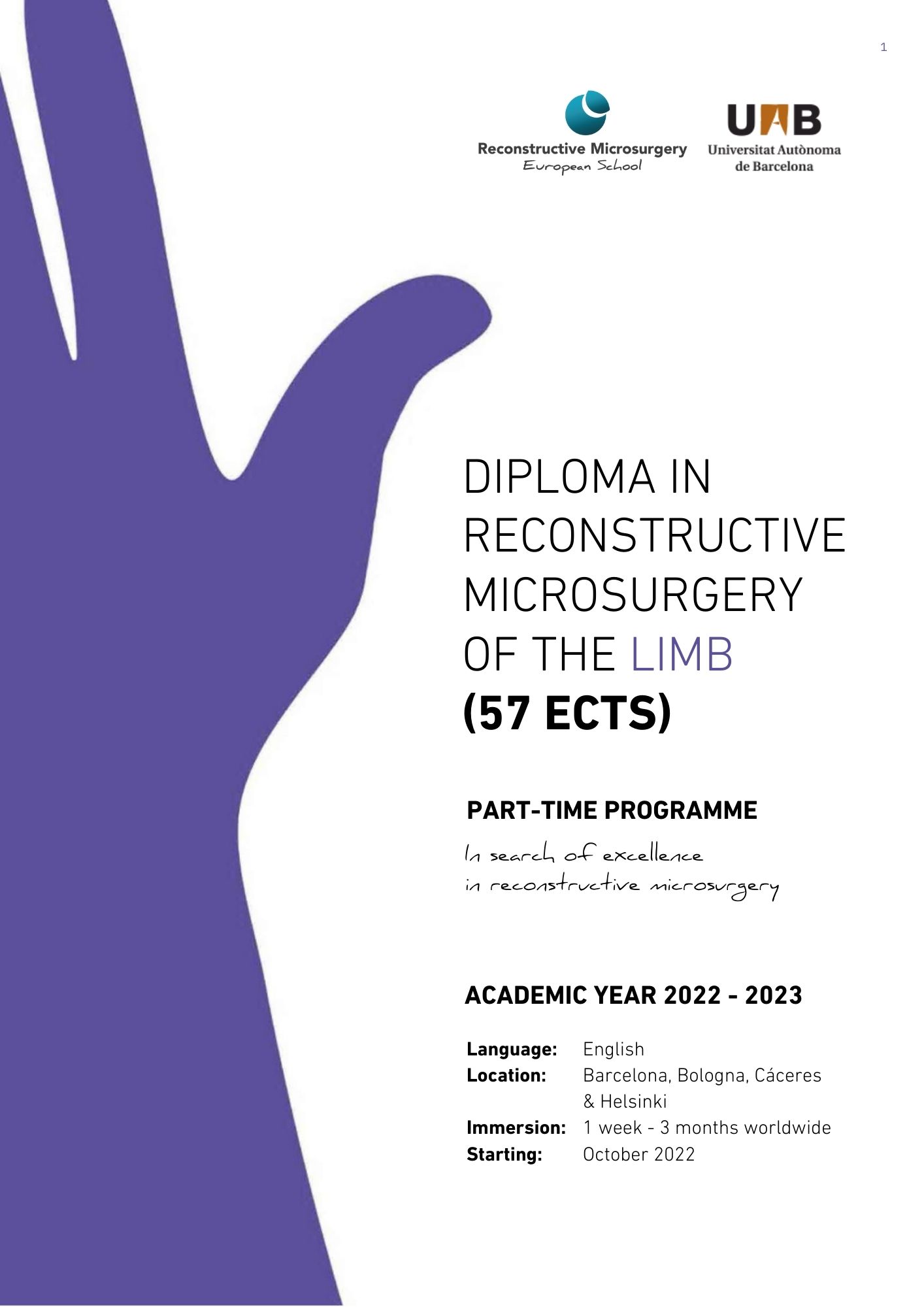
Limb Diploma educational programme (57 ECTS) consists in:
- 3 face-to face sessions held in 2 cities, 3 sessions on-line
- A period of clinical immersion training in out-standing hospitals around the world
- An online course to develop the methodological aspects of clinical research and a Final
If you are unable to travel, you have the possibility to take the clinical training modules on-line.
Theoretical introduction to the basic concepts of microsurgery:
- History of microsurgery
- Microscope and microsurgical instruments
- Selection of suture material for microsurgical procedures
- Basic & advanced skills in microsurgery
- Preoperative microsurgical planning
- Microsurgical flap monitoring
- Selection of right flap
- Microsurgical flap salvage
- Refinements in microsurgical reconstruction

Flap dissection training using a fresh cadaver model:
- Head and neck:
Submental flap / Temporo-parietal flap / Supraclavicular flap - Upper limb and shoulder:
Lateral arm flap / Radial forearm flap - Lower limb and pelvis:
Inferior gluteal artery perforator flap (IGAP) / Superior gluteal artery perforator flap (SGAP) / Thigh: anterolateral thigh flap (ALTF), medial thigh flap / Gracilis (ATMG) / Osteocutaneous peroneal artery perforator flap / Propeller flaps based on peroneal and tibial perforators / Medial plantar flap - Trunk:
Internal mammary fascio-cutaneous flaps / Intercostal flaps / Scapulo-dorsal flaps: latissimus dorsi, thoracodorsal artery perforator flap (TDAP), scapular flap, parascapular flap and chimeric flaps / Internal Iliac crest: Groin flap, superficial circumflex inguinal perforator flap (SCIP), iliac crest flap / Abdominal wall flaps: musculo-cutaneous rectus abdominis flap (TRAM), deep inferior epigastric perforator flap (DIEP) and Taylor, superficial inferior epigastric artery flap (SIEA) / Free lymphonode transfer
Intensive training course on basic microsurgical skills using a small animal model (rat):
- Basic management of experimental animal, microscope and instrumentation
- Microsurgical suture practice on surgical gloves
- Epineural and perineural suture of the sciatic nerve
- End-to-end suture of the carotid artery and femoral artery
- End-to-end suture of jugular and femoral vein
- Aorto-iliac end-to-end suture
- End-to-side suture of femoral artery and vein
- Jugular vein graft to carotid artery
- “In situ” groin flap
- Distant groin flap to the neck

Intensive course on dissection of perforator flaps in live animals (pig) and basic supermicrosurgical skills training:
- Perforator flap anatomy
- Preoperative planning of perforator flaps
- Dissection technique of perforator flaps
- Fundamentals of microsurgical techniques
-
Limb Reconstruction with Microsurgical Flaps
“Hands on” dissection section:
- Gluteal and dorsal perforator flaps.
- Free style perforator flaps.
- Transferring the flaps to the recipient vessels.
- Super microsurgical flaps.
- Lymphatic channel dissection.
- Lymph node transfer.

Small groups of students will have the opportunity to observe live microsurgical reconstruction of the upper limb.
Live webcast surgery will beshown and interactive participation will be facilitated
- Brachial plexus. Introduction and surgical anatomy
- Reconstructive alternatives in brachial plexus injuries. Neurotizations. Nerve grafts. Nerve transfers
- Obstetric plexus
- Surgical approach of the peripheral nerves injuries
- Reconstructive options in upper limb surgery: form, function and aesthetics
- Upper limb nonunion. Microsurgical bone reconstruction. Special locations: humerus, scaphoid
- Oncological management of upper limb tumors
- Replantation and revascularization in upper limb
- Toe-to-hand transfer
- Congenital hand
- Allotransplantation
Reconstruction of the upper limb defects:
- Latissimus Dorsi flap
- ALT flap
- TAP flap
- Radial forearm flap
- Osteocutaneus fibular flap
- SCIP flap
Small groups of students will have the opportunity to observe live microsurgical reconstruction of the lower limb.
Live webcast surgery will beshown and interactive participation will be facilitated
- Oncological management of limb tumors
- Reconstructive alternatives in lower limb surgery: form, function and aesthetics
- Reconstruction following high energy lower limb trauma
- Reconstructive approaches in chronic osteomyelitis of the lower limb
- Lower limb nonunion. Microsurgical bone reconstruction
- Lower limb nonunion. Microsurgical bone reconstruction
- Avoiding complications in lower limb reconstruction
- Reconstruction with epiphyseal flaps and joint transfer
Reconstruction of the lower limb defects:
- Latissimus Dorsi flap
- ALT flap
- TAP flap
- Radial forearm flap
- Osteocutaneus fibular flap
- SCIP flap
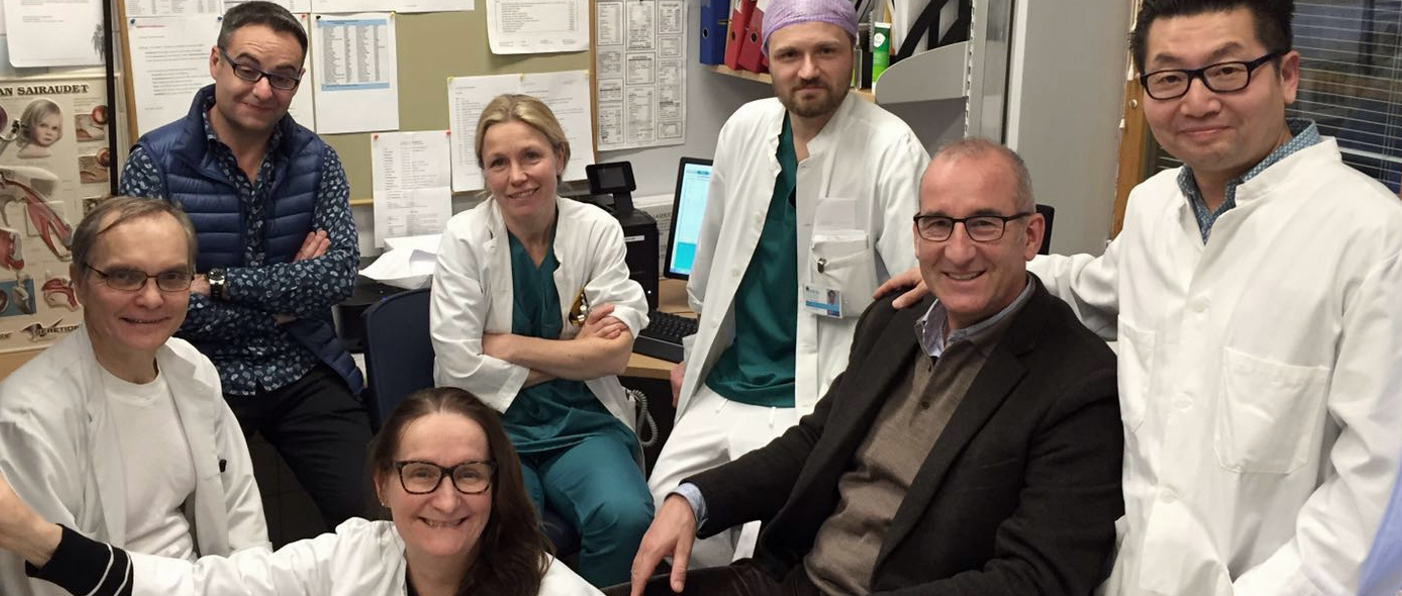
Small groups of students will have the opportunity to observe live microsurgical techniques in lymphedema treatment.
Live webcast surgery will be shown and interactive participation will be facilitated
- Acritical evaluation of results conservative treatment of Lymphedema
- Anatomy and physiology of the lymphatic system
- Assessment and surgical treatment of lymphedema
- Vascularised lymphatic node transfer
- Lympho-venous anastomosis
- Combined surgical treatment for lymhedema
- Lymphangiogenesis and the role of growth factors in lymphedema
- Free vascularised nerve flaps
- Microsurgical nanoflaps
- Patient selection to different methods
- Perforator to perforator flap surgery

The programme includes a practical training module with feedback from facilitators.
During this period, maximum 4 weeks, students will be involved in clinical cases involving breast reconstructive microsurgery. They will present cases to the other students and faculty to clarify doubts and evaluate the surgery.
From 1 week to 3 months before the end of June.
- Joint review of the microsurgical technique
- Presentation and discussion of complex clinical cases
- Resolution of immediate and delayed post-surgical complications involving the flaps
- Optimization of technique tailored to each student
On-line.
We need to investigate to produce knowledge that allows us to reduce the impact of health problems, which involves diagnosing and treating diseases better. The clinical research is this inescapable filter where the hypotheses that come from basic research, technological innovation or clinical practices must be tested. But for this applied research activity to be sufficiently valid and useful, we must adequately master the essential conceptual and methodological aspects related to the methodology of clinical research. Making it possible is the objective of this module.
At the end of the module, students will be able to:
- Understand and know how to apply the most important concepts related to clinical research.
- Know how to ask clinical questions of different types and in a structured way.
- Promote the design of the most appropriate clinical studies to answer the clinical questions of interest.
- Conduct searches on scientific publications in a structured, comprehensive and efficient manner.
- Carry out an adequate critical appraisal to identify the strengths and weaknesses of each study.
- Understand and apply the most basic statistical concepts to calculate the different measures of association and effect.
.
Final work
Preparation of a comprehensive written research report is an essential part of a valid research experience, and the student should be aware of this requirement at the outset of the project.
Interim reports may also be required. Sufficient time should be allowed for satisfactory completion of reports, taking into account that initial drafts should be supervised and corrected by your tutor.


